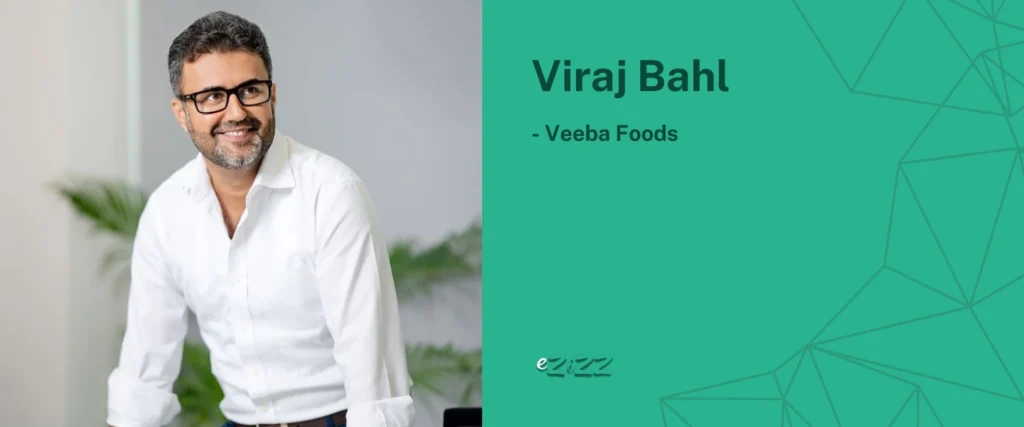If you’ve ever used a bottle of Veeba’s mayonnaise or chipotle sauce, you’ve tasted the vision of Viraj Bahl. He’s the founder of Veeba Foods, and he’s made it one of India’s most loved brands when it comes to sauces, dips, and spreads.
But here’s what sets him apart — he’s not just a businessman. He’s someone who genuinely understands food, flavors, and what the Indian consumer wants. His journey is not just about succes, it includes real struggles, calculated risks, and a clear sense of purpose.
He’s proof that you don’t always need a fancy launch — sometimes, clear intent and strong execution are enough.
Viraj Bahl’s Net Worth, Age etc (Personal Stats)
| Company | Veeba |
| Age | 43 |
| Net Worth | ₹739 Crore Approx. |
| Education | Singapore Polytechnic |
| Marital Status | Married |
Let’s Know about Viral Bahl
Viraj’s connection to the food industry didn’t start with Veeba — it actually started way back in his childhood. Viraj born into a Punjabi business family in New Delhi, he grew up around the hustle of a food business. His family was already involved in food manufacturing and distribution, primarily catering to hotels and restaurants.
This gave him a rare advantage, he didn’t just learn business from books; he saw it happen every day.
- His family owned a successful B2B food business
- He was exposed to real-time challenges like supply chain, product consistency, and customer demands
Unlike many young entrepreneurs who step into the business world clueless, Viraj already had a front-row seat to the food game.
The Education That Shaped Viral Bahl’s Vision
After completing his early education in India, Viraj went on to study in the UK. This international experience played a major role in shaping how he saw the food industry — especially the gap between Indian and global food standards.
He noticed something interesting during his time abroad: supermarkets were filled with high-quality sauces, salad dressings, and condiments. Back in India? Not so much.
- While abroad, he noticed how global food brands ensured quality, hygiene, and innovation.
- He realized that India lacked premium condiments that met international benchmarks.
- That’s when the idea struck — why not create a homegrown brand that does exactly that?
The Restaurant Business That Failed
Before Veeba, Viraj actually started with a different dream — he wanted to open a restaurant. Inspired by the global food scene and his love for flavors, he set up a QSR (Quick Service Restaurant) model in New Delhi, India. But things didn’t go as planned.
- He launched a restaurant business, which struggled and eventually failed.
- He Faced issues with scaling, operations, and customer retention.
- It was a tough phase — emotionally and financially — but also a turning point.
This failure wasn’t the end. It taught him some of the most important lessons: what not to do, how to listen to the market, and how to build something that’s scalable.
In Viraj’s own words from interviews:
“I knew I had to do something in food, but the restaurant wasn’t it. That failure taught me to think bigger — and more productively.”
How Veeba Was Born: From B2B to Brand?
After the restaurant business didn’t work out, Viraj went back to the drawing board. He wasn’t done with food — not even close. But this time, he wanted to go where the real opportunity was: behind the scenes, in the ingredients and sauces that restaurants used every single day.
So in 2013, he launched Veeba — not as a retail brand at first, but as a B2B solution.
- Veeba started by supplying sauces, dressings, and ingredients to global chains like Domino’s, KFC, and Starbucks in India.
- It focused on custom, high-quality products that these brands could trust.
- The approach was simple: top-notch quality, consistent taste, and timely delivery.
This behind-the-scenes success is what gave Viraj the confidence to take the next step — entering Indian households.
Transitioning to Retail: Winning Over the Indian Kitchen
Once Veeba had a solid reputation in the B2B world, Viraj realized there was a huge gap in the retail market too. Most Indian homes were still using generic, low-quality sauces — nothing close to what was available internationally. So, Veeba entered the retail game.
- The brand launched mayonnaise, chipotle sauce, salad dressings, and more — all with a focus on quality and taste.
- They didn’t just offer “foreign” flavors — they adapted them for Indian preferences (spicier, tangier, more flavor-packed).
- Packaging was clean, modern, and attractive — instantly making it shelf-friendly
What clicked? People could finally get restaurant-style sauces at home, without compromising on health or hygiene.
Today, Veeba is available in all major grocery stores, modern trade outlets, and online platforms like BigBasket and Amazon.
What Makes Veeba Different?
So many brands try to do what Veeba does, but few get it right. The difference lies in Viraj Bahl’s approach — he never cuts corners, and he never chases trends blindly. Everything is data-backed, quality-checked, and tailored to the Indian customer.
Here’s what really sets Veeba apart:
- Clean label products: Many Veeba products are free from harmful preservatives and artificial colors.
- Health-focused: There’s a whole range dedicated to low-fat, low-sugar, and kid’s nutrition.
- Innovation-first: From sandwich spreads to stir-fry sauces, Veeba keeps adding new categories.
- Global standards, local twist: Think Thousand Island dressing… with a hint of desi spice.
Viraj’s philosophy is simple but powerful:
“There’s no substitute for quality. If your product delivers on taste and health, people will come back.”
And they did. Over the years, Veeba has built a loyal customer base — both among chefs and everyday consumers.

